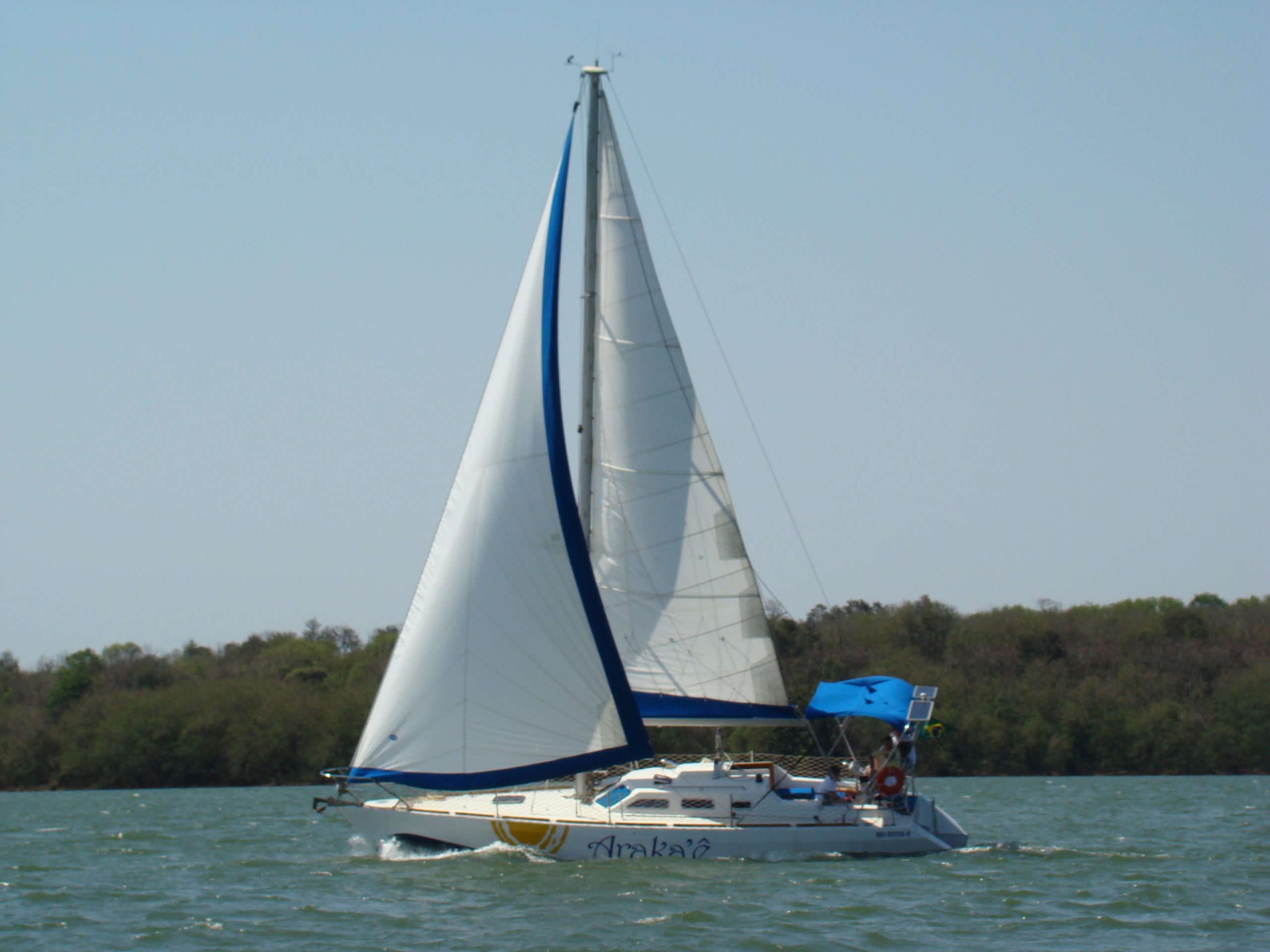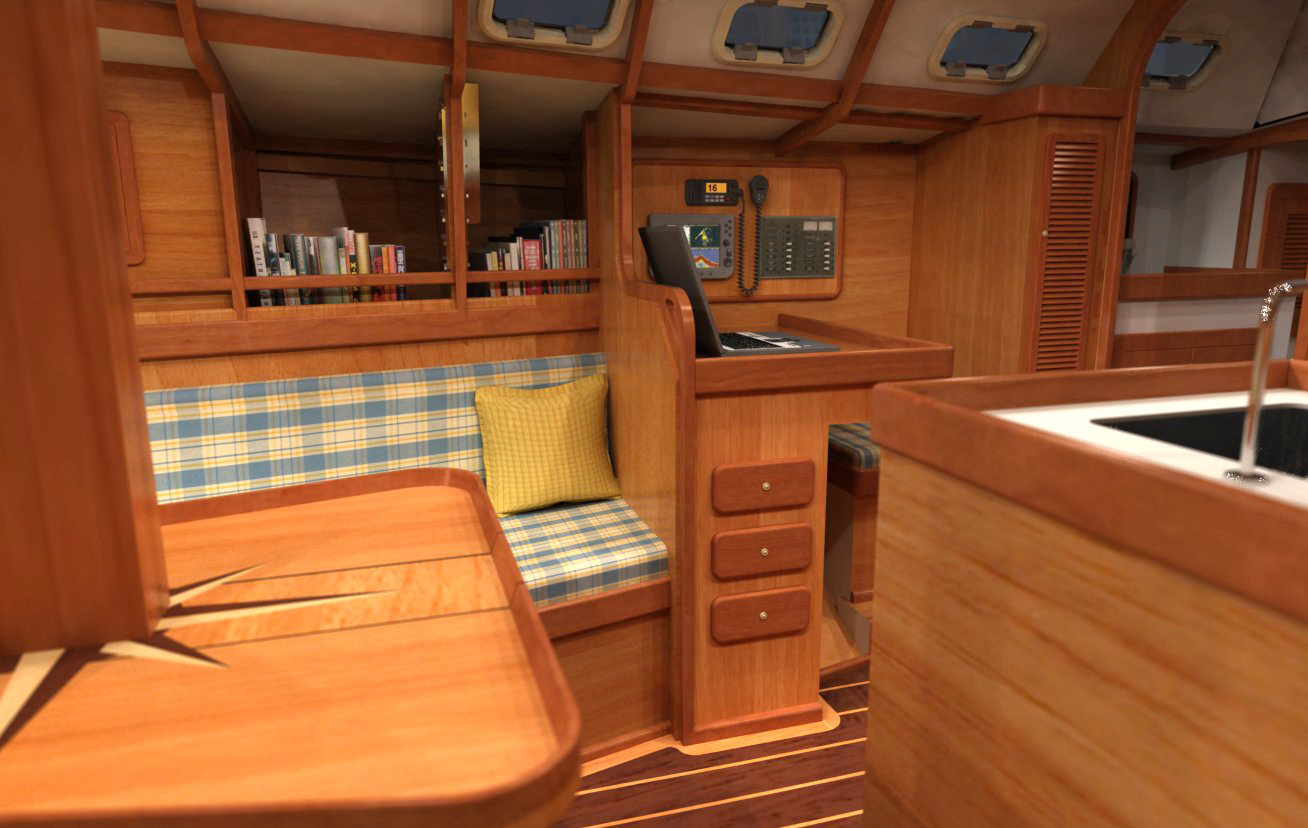The Multichine 31 breaks away from traditional parameters concerning beam/length ratios, having an impressive 3.54m maximum beam. The large beam provides this 31-foot cruising sailboat the equivalent amount of interior space normally found in 3~4 feet larger boats. The resulting design surpassed our expectations in appeal, comfort, and performance. The outcome was that, besides being the boat to beat in interior volume, it became recognized by their builders as one of the most stable and sea-worthy yachts of equivalent length to be found.
Increasing maximum width, provided that the beam at the waterline isn’t enlarged proportionally, enhances the qualities of the design in most aspects, with negligible influence in the final cost, or in number of working hours of building labour. In practical terms, perhaps the only possible drawback being the requirement for a wider shed to provide enough space for the construction, and the possible increase in red tape for further transportation when the boat would be moved from the shed to the water.
Another positive point of the wider beam is the fact that, in the case of monohulls, marina’s fees are charged according to the boat’s length overall. What means you can have the same interior comfort and save on the marina fees.
Dados Técnicos
Comprimento total
9.45 m (31’ 0”)
Comprimento da linha d'água
8.10 m (20’ 7”)
Boca Máxima
3.54 m (11’ 7”)
Calado
1.63 m (5’ 4”)
Lastro
1,450 kg (3,190 lb)
Deslocamento
4,500 kg (9,900 lb)
Capacidade dos tanques de água doce
360 l (95 gl)
Tanques de óleo diesel
120 l (32 gl)
Pé-direito
1.84 m (6’ 0”)
Área Vélica
44 m2 (474 sq ft)
Propulsão Auxiliar
21 hp
Método Construtivo
Ply-glass
Lista de Planos
MC31 – S0A – Full Size Stations A
MC31 – S0B – Full Size Stations B
MC31 – S0C – Full Size Stations C
MC31 – S0D – Full Size Stations D
MC31 – S0E – Full Size Stations E
MC31 – S0F – Full Size Stations F
MC31 – S1 – Lines Plan
MC31 – S2 – Mast and Sails
MC31 – S3 – Interior Layout
MC31 – S4 – Deck Layout
MC31 – S5 – Structural Plan
MC31 – S6A – Transverse Sections A
MC31 – S6B – Transverse Sections B
MC31 – S6C – Transverse Sections C
MC31 – S7A – Fin Keel
MC31 – S7B – Rudder
MC31 – S8 – Stem
MC31 – S9 – Custom Fittings
MC31 – S10 – Engine Installation
The inside layout of this boat is unquestionably one of the largest ever to be found in yachts this size. The most prized feature of the interior arrangement is the fact that from the companionway forwards it is one ambient only, without partitions that would jeopardize the feeling of amplitude and airiness.
A bulkhead just in front of the engine compartment separates the main saloon from the aft cabin and heads, and from there up to the forepeak the cabin is almost unobstructed.
Abaft this bulkhead are placed the owner’s cabin to port and the heads at the other side. The heads, besides being provided with a profusion of lockers, is spacious enough to have a shower with standing headroom.
Symmetrically, the aft cabin is fitted with a double-berth and a walk-trough entrance hall with its private sofa. A door separating it from the saloon area enhances privacy and comfort when having a larger crew onboard.
Going forward there is an ample galley to portside with two sinks, refrigerator, and a gimballed stove with oven. At the opposite side is placed the navigation station with a wet-suit locker abaft the backrest of the navigator. The navigation table is large enough to accommodate a nautical chart folded in half. Just in front of this area is placed a huge U-shaped dinette with plenty of room for seven persons to seat comfortably, or two adults to sleep when needed, one at each side. A curtain separates the main saloon from a second double berth placed above the height of the dinette’s front seat. Under the forward bunk there is stowage space for larger items, like inflatable dinghy, sails, spare anchors, etc.
The deck with its wedged cabin trunk and a well-protected cockpit area is “clean” and functional, offering a special feeling of safety to the crew. The traveller placed in front of the main hatch gives room for a dodger that can extend to the front part of the cockpit, a welcome feature when the going gets tougher. With inboard shroud chainplates installed and a wide side-passage to the foredeck, the Multichine 31 is an easy boat to be manoeuvred by a shorthanded crew. The original version of the design contemplates tiller steering. However, there is the option of wheel steering already detailed in the plans, since a considerable number of our clients prefer a wheel arrangement.
For offshore voyaging with the assistance of a vane gear or external autopilot, the cheapest solution available, tiller arrangement is simpler and more reliable, even though both systems can be adopted. Nevertheless, tiller is less intrusive in crew’s circulation around the cockpit area, besides being much cheaper to install. Another point worth mentioning related to crew’s free access to the cockpit is its transom scoop platform with swimming ladder hinged to it. This arrangement is super-comfortable when the boat is being intensively used, as when coming aboard with heavy stores, or when using diving gear.
The two spreaders fractional sloop rig specified for the MC31 is simple, efficient and strong, allowing easy manoeuvrability with plenty of safety margin. The overlapping moderate-sized foresail is a good compromise in performance and sail handling.
The MC31 is a boat of relatively shallow draught (1.63m). It’s very successful bulbous keel design acting together with its generous beam ensure a high degree of positive stability, enhanced by a high ballast ratio. Recognised by our builders as one of our “trademarks”, the MC31 rudder blade dimension is much above average in size, affording a good steering control even when sailing in steep running seas. The moderate foot dimension of the mainsail, together with a high aspect ratio of the sail plan, contribute for the good balance of the boat, especially when sailing close-hauled.
If you want to build your own boat, perhaps the most important concern you may have is if you are going to overcome the various challenges you will have to face along the whole building process. Being aware of this we specified the MC31 to be built employing the most comprehensive of the building techniques, the plywood/epoxy building method. The polygonal cross section typical of multi-chine hull shape is also a welcome simplification when sheathing the hull. The process consists of applying 10mm thick plywood panels, glued with epoxy, over a transverse structure of bulkheads or semi-bulkheads, and then encapsulating the whole hull with fibreglass saturated with epoxy resin. Internally, two coats of epoxy should be applied on all exposed plywood panels to ensure a perfect waterproof seal of its whole interior surface. The deck is built in the same way, resulting in a watertight, light and strong mono-block structure that will last for ages, almost maintenance free.
The plywood/epoxy building method can be considered a break-through in amateur boatbuilding, since, according to our files, there are more sailboats built by this process when their owners complete the jobs successfully than by any other building method. The frames are built on the work bench, together with deck-beams, cockpit framing, and even the transversal furniture, forming very rigid rings on top of which the hull panels will be attached. An important part of the finishing job is already accomplished when the boat is turned over, saving precious time and enhancing the precision and quality of the work. The finished boat is immensely strong, placing the Multichine 31 among the most reliable and maintenance free cruising sailboats one can obtain.
Fotos e Imagens
Outros Planos
Images and Videos produced by customers































